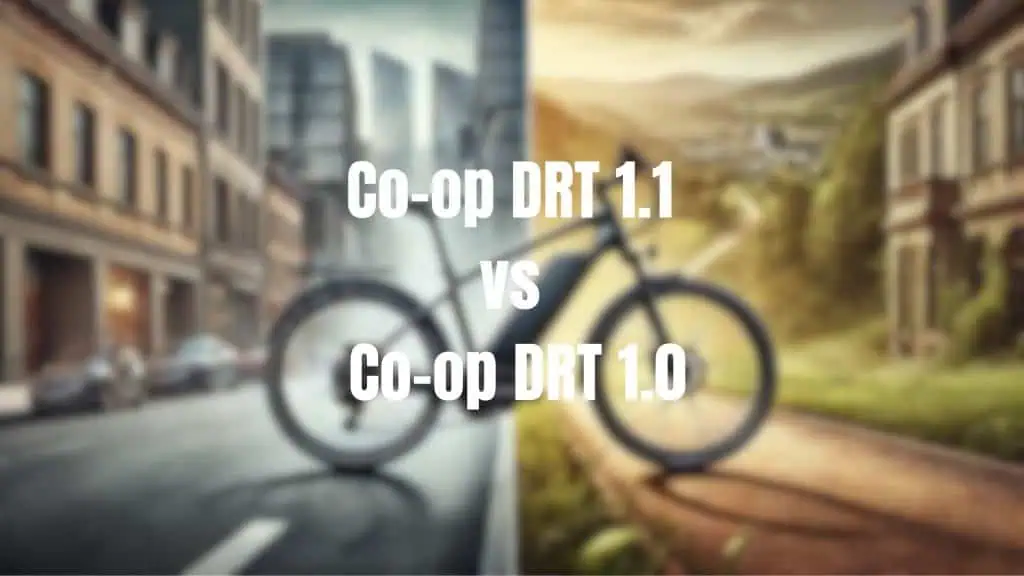Co-op DRT 1.1 vs Co-op DRT 1.0: A Comparison

Co-op DRT 1.1 and the Co-op DRT 1.0 are both entry-level mountain bikes from REI’s Co-op Cycles line. While they share many similarities, there are some key differences that could make one more suitable for certain riders. This detailed comparison will help you understand the nuances of each model to determine which might be the better fit for your mountain biking needs.
Comparison Table
| Feature | Co-op DRT 1.1 | Co-op DRT 1.0 |
|---|---|---|
| Price | $599.00 | $599.00 |
| Bike Type | Mountain Bike | Mountain Bike |
| Frame Material | 6061 aluminum | 6061 aluminum |
| Wheel Size | 27.5 inch | 26 inch |
| Suspension | Front Suspension | Front Suspension |
| Drivetrain | Shimano | Shimano |
| Gearing | 21 gears | 21 gears |
| Brakes | Hydraulic Disc | Hydraulic Disc |
| Weight | 31 lbs. | 31 lbs. |
Price and Value
Both the Co-op DRT 1.1 and DRT 1.0 are priced at $599.00, making them equally accessible options for entry-level mountain bikers. The identical pricing suggests that the main differences between these models lie in their specifications rather than their overall quality or value proposition.
Bike Type and Frame Material
Both bikes are classified as mountain bikes and use 6061 aluminum for their frames. This material choice offers a good balance of strength, light weight, and affordability, which is ideal for entry-level mountain bikes. The frame geometries are likely very similar, both designed to provide stability and control in off-road conditions.
Wheel Size
- Co-op DRT 1.1: 27.5 inch
- Co-op DRT 1.0: 26 inch
This is the most significant difference between the two models. The DRT 1.1’s 27.5-inch wheels offer a good balance between the agility of smaller wheels and the roll-over ability of larger ones. They’ve become increasingly popular in recent years for their versatility on various types of terrain.
The DRT 1.0’s 26-inch wheels, while less common on newer bikes, offer excellent maneuverability, particularly in tight, technical terrain. They’re also typically lighter, which can make the bike feel more responsive.
Suspension
Both bikes feature front suspension, which is essential for absorbing impacts and vibrations from rough trails. The suspension forks on both models are likely similar in quality and travel, providing improved comfort and control in off-road conditions compared to rigid forks.
Drivetrain and Gearing
Both the DRT 1.1 and DRT 1.0 use Shimano drivetrains with 21 gears. This wide range of gears is beneficial for tackling varied off-road terrain, providing options for both steep climbs and fast descents. The consistency in drivetrain between the two models suggests that shifting performance and gear range will be very similar.
Brakes
Both bikes are equipped with hydraulic disc brakes, ensuring excellent stopping power and control in various conditions. This is a high-quality feature for bikes at this price point, offering superior braking performance compared to mechanical disc or rim brakes, especially in wet or muddy conditions.
Weight
Both the DRT 1.1 and DRT 1.0 weigh 31 lbs. This consistency in weight, despite the difference in wheel size, suggests that Co-op Cycles has balanced other components to maintain the same overall weight. This weight is reasonable for entry-level mountain bikes with front suspension.
Riding Experience and Terrain Suitability
While both bikes are designed for off-road use, the difference in wheel size may affect their optimal terrain:
- The DRT 1.1, with its 27.5-inch wheels, may feel more stable at higher speeds and roll over obstacles more easily. It might be better suited for riders who plan to tackle a variety of trails, including some more challenging terrain.
- The DRT 1.0, with its 26-inch wheels, might offer better acceleration and feel more nimble in tight, technical sections of trail. It could be preferable for riders who prioritize maneuverability or those who will be riding primarily on narrower, more technical trails.
Which is Better?
The choice between the Co-op DRT 1.1 and DRT 1.0 largely comes down to personal preference and the type of terrain you plan to ride most often:
- Wheel Size Preference: If you prefer the newer 27.5-inch wheel standard, go for the DRT 1.1. If you like the responsiveness of 26-inch wheels, choose the DRT 1.0.
- Terrain: For more varied terrain and potentially faster riding, the DRT 1.1 might have an edge. For tighter, more technical trails, the DRT 1.0 could be preferable.
- Future-Proofing: The DRT 1.1’s 27.5-inch wheels are more in line with current trends, which might make it easier to find replacement parts in the future.
- Rider Size: Smaller riders might find the 26-inch wheels of the DRT 1.0 more suitable, while taller riders might prefer the 27.5-inch wheels of the DRT 1.1.
In conclusion, both the Co-op DRT 1.1 and DRT 1.0 offer excellent value for entry-level mountain bikers. They share many key features, with the main difference being wheel size. The DRT 1.1 might be better for riders looking for a more versatile bike that aligns with current trends, while the DRT 1.0 could be ideal for those who prioritize maneuverability or have a preference for 26-inch wheels.
Consider test riding both bikes if possible, as the feel of different wheel sizes can be quite personal. Also, think about the type of trails you’ll be riding most often and which wheel size might be better suited to those conditions. Regardless of your choice, both bikes provide a solid platform for getting into mountain biking.






